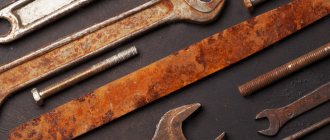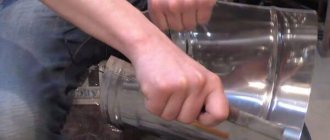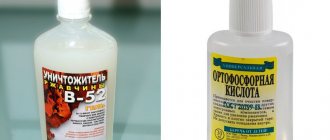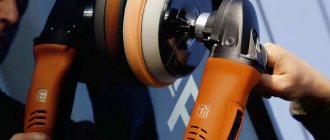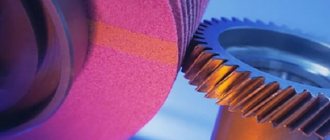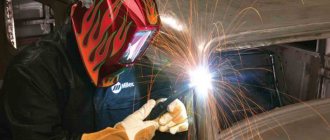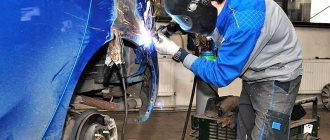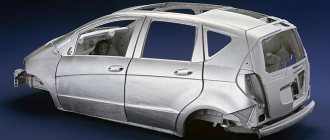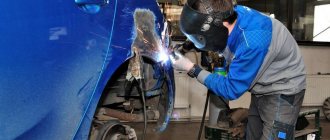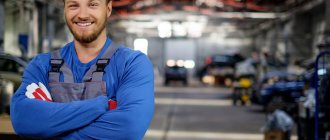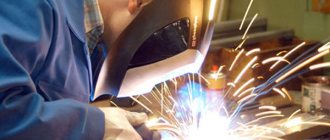The need to prepare metal products for painting is due to an increase in the adhesion characteristics of the substrate to the paint and varnish material and the resistance of the metal to corrosion processes. All this will have a positive effect on the service life of the painted products. However, most owners are much more concerned about the presence of rust, which must be removed during the metal preparation process, than about degreasing, which is why painting work is carried out without this important and mandatory operation.
Corrosion formation
Metal corrosion , or simply rust, appears as a result of metal oxidation under the influence of the environment. The main reason for its appearance is damage to the paint on the car body.
All resulting scratches and chips sooner or later become a source of rust formation, which gradually spreads deeper into the stain and over the entire larger surface area of the body.
The rate at which corrosion spreads depends on the aggressiveness of the environment and the condition of the body itself. For example, in the winter season it spreads many times faster.
It is much easier to deal with a single rust stain that has just appeared than with multiple “saffron caps” or an old stain where the metal is corroded almost completely.
The appearance of corrosion that is not yet visible to the eye is indicated by swelling of the paintwork. Such areas should be immediately cleared of old paint and cleaned.
Types of body corrosion
Among the most common types of body corrosion are:
- Chemical. The main catalyst is the surrounding part. The metal product gradually begins to oxidize. The biggest danger is contact with moisture. After all, it may contain various substances and additives. Even air is chemically dangerous for metal, especially in places with a very poor environment.
- Mechanical. Caused by the impact of significant mechanical load on the body. This process especially often manifests itself along with electrochemical corrosion, in places of mutual contact and connection of materials.
- Electrochemical. The likelihood of such body corrosion developing is especially high during the cold season. This is due to the fact that there is a lot of salt, sand and other reagents on the road. In contact with steel, they create a cathode-anode connection. As a result, the metal surface quickly deteriorates.
Vulnerable places
The areas that experience the greatest mechanical stress are the most susceptible to corrosion. These include:
- thresholds are among the first to suffer from corrosion;
- hood – small pebbles from the vehicle in front provoke the appearance of numerous chips;
- wheel arches are constantly exposed to aggressive chemicals.
It is important to promptly detect emerging rust and eliminate it, preventing the further spread of corrosion. To do this, you need to know how you can deal with this unpleasant phenomenon yourself.
Corrosion Removal Methods
Corrosion can be eliminated in the following ways:
- Mechanical – used for severe corrosion, it involves removing rust by stripping down to metal, followed by priming, puttying and painting the area of the body being repaired;
Advantages of the method: elimination of large and deep stains, damage under swelling paint, as well as low cost and availability of the necessary materials.
Disadvantages: length of the process.
- Chemical - involves using rust removers. Such reagents are widely represented on the modern market.
Advantages of the method: elimination of corrosion in hard-to-reach places, higher process speed.
Disadvantages: inability to use on heavily damaged areas.
Let's consider the process of eliminating corrosion using each of the methods presented above in more detail.
Step-by-step instruction
Before starting repair work, it is necessary to inspect the body and identify all problem areas. Assess the degree of damage and decide on a method to eliminate corrosion.
Tools and materials
Before starting work you need to prepare:
- grinder;
- sandpaper;
- degreaser;
- putty;
- primer;
- paint;
- car varnish;
- rust converter;
- masking tape;
- clean cloth.
Popular drugs
The most popular chemicals for removing rust from a car body with your own hands are:
- orthophosphoric acid is the most well-known remedy; it can be used in its pure form or be part of various chemistry;
- VSN-1 Neutralizer - easily copes with rust, turning it into a dark mass;
- zinc – a kit for removing rust and further galvanizing the metal by applying a special protective layer using an electrochemical method. Requires connection to battery. The process of working with the Zinkor product can be seen in detail in the video clip:
Often, car owners want to quickly and without unnecessary hassle remove visible traces of corrosion from the car body. In this case, you can use special products, such as Anti-Rust paste.
It will quickly eliminate noticeable rust marks from the surface of the body, but will not eliminate the source of the spread itself. Therefore, this effect will last no more than a month. As a rule, owners resort to this method during pre-sale preparation of the car.
Mechanical method
Removing rust stains mechanically is carried out in several stages:
- cleaning corrosion down to metal with sandpaper. The work can be done manually or using a power tool, such as a grinder. The stain should be cleaned gradually and carefully, avoiding rough scratches. It is important not to damage entire areas of the paintwork and to carry out 100% complete stripping down to “bare” metal.
- treating the prepared area of the body with a rust converter in order to eliminate the smallest corrosion residues that are not always visible to the eye.
- degreasing the surface after the converter ends (on average after half an hour);
- putty (carried out in several layers if necessary) and grinding of the treated surface;
- painting in body color (before painting, protect adjacent parts of the body with newspapers and masking tape and apply an anti-corrosion primer in 2-3 layers). Painting is also carried out in 2-3 layers, each thoroughly drying.
- application of clear varnish (if desired) for more reliable protection and a beautiful appearance.
The result of the work will depend entirely on compliance with all instructions and the correct execution of the work. If the technology is violated, for example, due to poor-quality cleaning or insufficient drying, the result of the work may be completely short-lived.
Watch a video on how to remove rust from a car in 10 minutes:
Chemical method
The significant difference between this method and the previous one lies only in the first stage - cleaning from rusty stains. Instead of mechanical cleaning, specialized chemicals are used. It can remove rust and prevent its further spread without damaging the metal.
As a rule, such preparations are applied to the problem area in accordance with the manufacturer's instructions for the specified time, after which the remaining product is wiped off or washed off.
However, to obtain an excellent and long-lasting result, you will also have to putty, sand and paint. When eliminating minor damage to the body, you can do without these steps.
How to quickly remove rust from a car - electrochemical method
The electrochemical method of removing rust from a car body involves performing an oxidation-reduction process on the affected area. The reaction itself takes place in an electrolyte under the influence of current. This is a complex process. But if you look at it, it turns out that this is the simplest method of getting rid of corrosion.
Advantages of the method:
- Complete rust removal.
- Availability and simplicity.
- Formation of a zinc layer to protect the metal in the future.
- The method is harmless to undamaged paintwork.
- Quick results.
For the procedure you will need:
- A piece of metal wire.
- Two stainless steel electrodes (one with a zinc tip).
- Corrosion converter.
- Zinc chloride solution.
To remove rust you need:
- Connect the wire to the positive terminal of the battery.
- Make a cotton tip on the tip of the electrode and dip it into the transducer.
- Carefully apply the tip to the area damaged by rust.
- Connect the second electrode with a zinc tip to the battery cable instead of the first electrode.
- Make a fabric wrap around the zinc tip.
- Dip the electrode into the zinc chloride solution and run it over the cleaned area of the metal to create a protective layer.
What is defatting
The essence of the procedure is to remove fatty substances from the surface of the substrate, which are often present in cooling emulsions, mineral oils, preservative lubricants, and polishing compounds. Degreasing of the metal surface before painting also has to be done to remove residues from washing and etching, traces of sweat and fingers. All these contaminants can extremely negatively affect the quality of surface wetting with paints and varnishes, as well as harm film formation and other properties of the coating.
Depending on the amount of fatty impurities present per square meter, several degrees of surface contamination can be distinguished:
- Weak - up to 1 g;
- Medium - from 1 to 5 g;
- Increased - more than 5 g.
When processing fats with chemical reagents, several sequential processes occur on the surface:
- Solvent;
- Emulsifying;
- Saponifying.
Depending on the ability of fats to be destroyed under the influence of solvents, several types of contaminants are distinguished:
- Non-destructible - for example, emulsions.
- Pollinated - polishing materials, lubricant residues.
Chemical methods
The main type is organic solvents, which allow you to quickly remove grease and oily areas from metal parts. They are most widely used in individual production, although sometimes they are used in serial production, but not often due to their high explosion and fire hazard. The desired effect, namely the dissolution of oil and fat deposits, is achieved at the moment of contact of organic solvents with them.
The quality of surface degreasing is directly affected by the degree of solvent contamination, since the more fats are contained on the surface, the worse the chemical’s ability to dissolve existing deposits becomes. Most often, aliphatic and chlorinated solvents are used to remove fat and oil areas. Despite their high efficiency in metal cleaning, they have a serious drawback - these compounds are not able to remove abrasive materials and other mineral contaminants from the surface.
Aqueous solutions
As is known, water has poor purification ability, which is associated with significant surface tension and incompatibility with fats. Therefore, when it wets greasy surfaces, stable emulsions are not formed. To increase the cleaning properties of an aqueous solution, manufacturers resort to various techniques - increasing the pH acidity level, increasing the temperature regime of use to the range of 50-65 degrees Celsius, and introducing surfactants into the composition.
Alkaline degreasers
These compounds have a lot of positive properties. These include high cleaning ability, fire safety, environmental friendliness, and a wide selection of application methods. When treated with aqueous solutions of saponified fats and oils, the latter are inevitably destroyed, and unsaponifiable contaminants are emulsified. The latter case can be described as the process of detachment of fatty layers from the surface with gradual transformation into a working liquid and removal along with the working solution. The main disadvantage of these compositions is the need for anti-corrosion treatment of the surface after cleaning.
Among the components present in cleaning solutions, surfactants - surfactants - deal best with fatty and oily areas. Once on the surface, they form foam on it, simultaneously reducing interfacial and surface tension, increasing wettability and destroying solid and liquid contaminants, transforming them into a more convenient form for removal. The surfactant content in grease cleaners , as a rule, fluctuates within 10%.
If the need arises, along with degreasing, to remove thin oxide or hydroxide films, acidic solutions containing 1-3% phosphoric acid are used.
After treating surfaces with cleaning compounds, they must be washed with water. The presence of salt residues is unacceptable, since they can destroy the properties of paint films, increasing moisture permeability and accelerating the development of under-film corrosion.
Emulsion compositions
In cases where there is a need to remove oil deposits, grease, and difficult-to-remove contaminants from the surface, emulsion degreasing is used. This method is combined and has the advantages of organic solvents and aqueous alkaline solutions. These compositions contain emulsions of solvents and surfactants diluted with water. Chlorinated or aliphatic hydrocarbons can be used as solvents.
Ultrasonic and electrochemical methods
To increase the cleaning ability of detergent compositions, special baths with an ultrasonic field are used. This method is most relevant for small-sized products with a highly complex surface, for which it is important to remove contaminants with the highest quality possible. For large parts, it is not practical to use this method due to economic considerations, since there is a need to increase the output power of the device.
When preparing metal products using the electrochemical degreasing method, specially equipped baths are also used, and the process itself is carried out due to the action of gas bubbles formed on the electrodes. This makes it possible to reduce the consumption of components of chemical compositions and improve the quality of surface treatment.
The best corrosion converter sprays
The most popular form of release of corrosion converters is sprays.
WURTH
This German product is made using special chemicals. It is easy and convenient to apply even in hard-to-reach areas. After all, there is a long nose here. This converter has excellent penetrating ability, it is perfectly absorbed and instantly dissolves rust.
WURTH protects against further damage and is suitable for all metal surfaces.
Advantages:
- Excellent penetrating ability.
- Squeezes moisture out of electrical contacts.
- Formation of a protective layer.
Flaws:
- High price.
- Very flammable, you have to be careful.
KUDO
This product is made on an acid basis. KUDO deeply affects rust, removes it and protects it from secondary appearance. After treatment, a film is formed on the surface, which reliably protects the car body from subsequent negative influences. The converter has a lasting effect and is not washed off after treatment.
Advantages:
- Quick and easy application.
- Affordable price.
- Dries quickly.
- No smell.
Flaws:
- There is no embossing effect promised by the manufacturer.
Hi-Gear Rust Treatment No-Rust
This is one of the most famous and popular converters among domestic drivers. This is due to the fact that the product contains quite aggressive components. They quickly eat away rust and turn it into soil. Hi-Gear Rust Treatment No-Rust comes in an aerosol spray form. Powerful directional flow ensures deep and uniform penetration of the transducer.
Advantages:
- Maximum penetration of the product.
- Improves adhesion with various types of varnishes and paints.
- Quick results.
- Long-term protection.
- Comfortable application.
Flaws:
- The product will corrode the paint.
- Can only be used outdoors.
- It is necessary to wash off with alcohol.
Paint selection
Just a few years ago, oil paints were used to paint metal structures. Nowadays, a large number of different options have appeared that can be used instead of this traditional method. Craftsmen now have access to acrylic materials based on epoxy and alkyd bases, those that can be diluted with water.
The main thing is to choose a mixture that includes anti-corrosion components. The ideal option is one that contains rust converters. Of course, the price tag for them is a little higher, but this coating will last a very long time.
Rating of liquid products
Among the anti-corrosion liquids for the car body, the following are perfect.
FENOM FN956
This is one of the best liquid corrosion converters. Its effectiveness has been proven by many tests - the FENOM FN956 composition easily transforms rust up to 100 microns thick. After drying, the metal surface is covered with a durable crust based on manganese and iron compounds.
Advantages:
- Rust protection for up to seven years.
- Can be easily used for preserving metal without painting.
Minuses:
- Insignificant volume.
- Great cost.
YasKhim
YasChem is a universal and affordable drug. Essentially, it is phosphoric acid diluted with water and additional components. The drug retains its qualities even after defrosting.
Advantages:
- High efficiency.
- Affordable price.
Minuses:
- There is no effect of tinning, galvanizing or other protection.
Chemist
This product easily removes corrosion and protects the body metal from future relapses. After applying the drug Khimik, a zinc coating appears on the surface and a layer of primer is formed. The latter helps to significantly improve the adhesion of the treated metal to paint and varnish.
Advantages:
- It acts quickly and does not require rinsing.
- Prevents relapse.
- Easily removes rust.
- Reliably protects the surface from corrosion.
Minuses:
- Corrodes paint.
- Toxic.
Thermal method
Cleaning metal from signs of corrosion is often done thermally. An oxy-acetylene torch is used for heating. The entire rusty surface is treated with a burner. After completing the procedure, old paint, rust and mill scale burn out and are easily removed.
In order to prevent the re-formation of rust, it is recommended to treat metal products with anti-corrosion compounds.
Gel
Another option for the release form of corrosion converters is gel.
Permatex
This corrosion converter comes in a gel form. It can be easily applied to rusty areas using a spatula. The gel will instantly form a layer of protection. Permatex does not run down and is effective within a couple of minutes after the start of application. In case of a significant layer of rust, another treatment with the drug will be required after half an hour.
Advantages:
- No rinsing required.
- Protects the surface from relapse for a long time.
- Effectively removes any rust.
- Works like a real primer.
- Easy to apply, does not bubble or flow.
Minuses:
- High price.
KerryGel formula KR-240
The main active ingredient of the product is phosphoric acid. It is supplemented with a special structure modifier. The latter destroys the crystalline rust lattice to allow the active substance to penetrate directly into the rust. After the processing process, the metal is coated with a zinc-iron phosphate film. It reliably protects the surface from the reappearance of rust.
Advantages:
- Creates the effect of cold galvanizing.
- Penetrates rust quite deeply.
Minuses:
- Without repeated treatment, it has little resistance to relapse.
- The product must be washed off.
B-52 Vershina
Gel B-52 Vershina has a viscous consistency, which is convenient when applied to vertical metal sheets. The composition does not drip and does not leave puddles or streaks. The reaction with rust is very strong, since the formula of this product includes a mixture of aggressive salts and mineral acids.
Advantages:
- Affordable price.
- Convenient to use.
Minuses:
- Does not convert rust into soil.
- Does not form protective layers on the surface.
How to degrease metal before painting
In domestic conditions, owners, as a rule, use proven “old-fashioned” products - gasoline, kerosene, acetone, alcohol.
But today more modern and technologically advanced formulations are available. Among them, Nefras (White Spirit), Solvent 646 are quite popular. They have a lot of advantages - affordable price, increased level of environmental friendliness, the ability to form films that are more resistant to paintwork, which helps prevent the development of corrosion processes.
The problem for many owners is that the substrate after degreasing does not match the chosen paint. This can be avoided by purchasing a solvent suitable for the coating being treated. But more often than not, such problems do not arise when using solvent No. 646 . Consumer reviews talk about its versatility, so there is no need to carry out additional operations.
Another popular type of solvent is Antisilicone. These compounds are in high demand among craftsmen, who use them to degrease the car body before subsequent painting. However, safety rules must be observed during operation. In the room where degreasing work is carried out, windows and doors must be opened. Such solvents can be used as far as possible from sources of ignition and always wearing personal protective equipment.
The most effective are special concentrated solutions - Chistomet, Docker Dekamet and others. The main active component in these products is alkali. They also contain additional substances - inhibitors, surfactants, additives, etc. Before use, the concentrate is mixed with water in pre-calculated proportions. It all depends on the degree of contamination of the surface being treated. The advantages of these solutions are their high environmental friendliness and safety. They can be used not only to degrease the surface, but also to increase the anti-corrosion resistance of the metal. Can be used in industrial enterprises.
Corrosion protection
Follow the simple tips below to protect your car from corrosion:
- wash your car regularly;
- install mudguards (if you don’t have them);
- treat the car with polishing agents (such as “liquid glass”);
- carry out anti-corrosion treatment on the underbody of the car.
Regularly inspect your clean car for problem areas. Remove any small stains that appear in a timely manner. Remember: severe advanced corrosion will lead to expensive body repairs.
Take good care of your car, and then the methods described above will not be useful to you!
